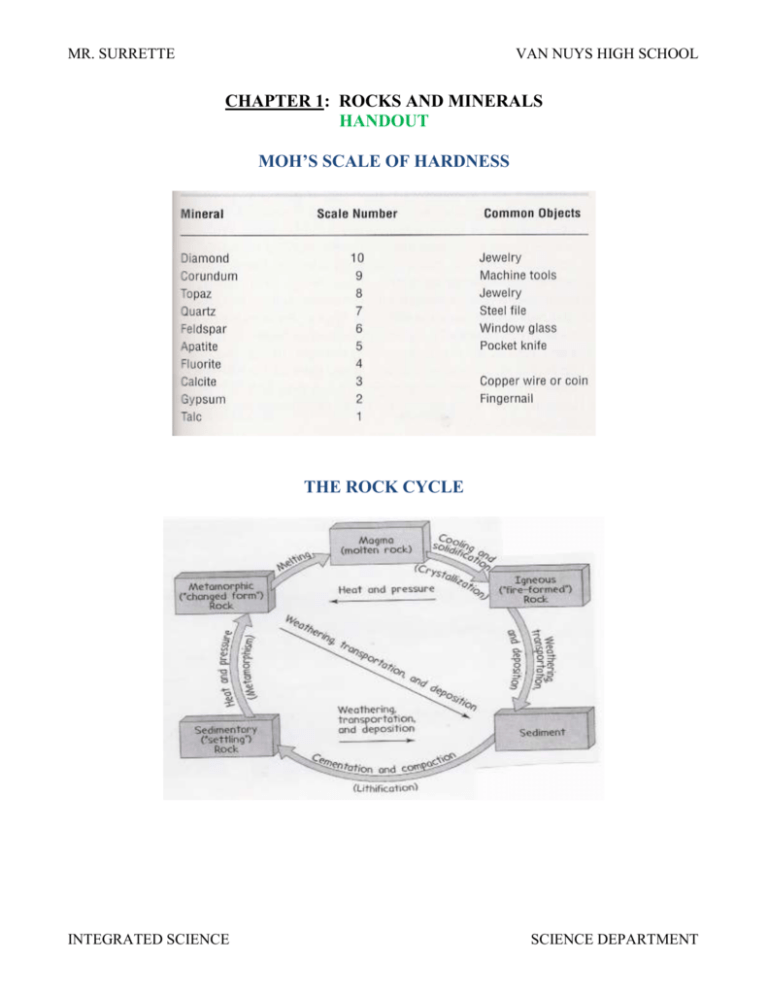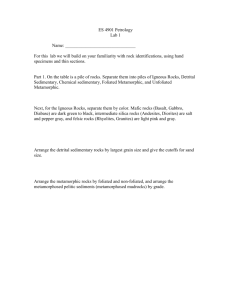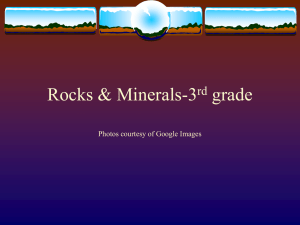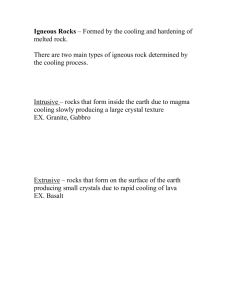ROCKS AND MINERALS QUIZ
advertisement

MR. SURRETTE VAN NUYS HIGH SCHOOL CHAPTER 1: ROCKS AND MINERALS HANDOUT MOH’S SCALE OF HARDNESS THE ROCK CYCLE INTEGRATED SCIENCE SCIENCE DEPARTMENT MR. SURRETTE VAN NUYS HIGH SCHOOL CHAPTER 1: ROCKS AND MINERALS WORKSHEET 1. __________ rocks are formed from weathered material. (A) Igneous (B) Sedimentary (C) Metamorphic (D) Extrusive (E) Intrusive 2. The name given to the color of a mineral in its powdered form is: (A) luster (B) streak (C) shade (D) tint (E) powdered 3. What is the density of a metal if 4cm3 of it weighs 13 grams? (A) 4 g/cm3 (B) 7.5 g/cm3 (C) 3.25 g/cm3 (D) 2.25 g/cm3 4. The most abundant mineral in Earth’s crust is (A) silicon (B) carbon (C) iron (D) nitrogen (E) 5.25 g/cm3 (E) oxygen 5. On the ocean floor, __________ is the most common igneous rock. (A) pyrite (B) silica (C) granite (D) basalt (E) quartz 6. The process where solid crystals is called: (A) crystallization (B) evaporation (C) sublimation (D) freezing (E) melting 7. __________ rocks have cooled slowly beneath the Earth’s surface. (A) Extrusive igneous (B) Sedimentary (C) Metamorphic (D) Intrusive igneous (E) Granite 8. These rocks provide information about geological events that occurred at the Earth surface. (A) Extrusive igneous (B) Sedimentary (C) Metamorphic (D) Intrusive igneous (E) Granite 9. __________ metamorphism involves mechanical deformation of rock. (A) Dynamic (B) Physical (C) Contact (D) Weather (E) Regional 10. __________ metamorphism is the wide scale alteration of rock. (A) Dynamic (B) Physical (C) Contact (D) Weather (E) Regional 11. __________ rocks are formed by the cooling and crystallization of hot molten rock. (A) Igneous (B) Sedimentary (C) Metamorphic (D) Extrusive (E) Intrusive 12. Out of the following choices, __________ has the least hardness. (A) calcite (B) talc (C) topaz (D) quartz (E) fluorite 13. All __________ contain the CO3-2 ion. (A) hydrocarbons (B) alkanes (C) carbonates (D) sulfates (E) nitrites 14. When low-silica magma erupts from a __________ volcano, lava flows freely and far. (A) composite (B) cinder cone (C) dormant (D) active (E) shield INTEGRATED SCIENCE SCIENCE DEPARTMENT MR. SURRETTE VAN NUYS HIGH SCHOOL 15. __________ physically breaks a rock into smaller and smaller pieces. (A) Chemical weathering (B) Erosion (C) Physical weathering (D) Recrystallization (E) Mechanical deformation 16. __________ rocks are formed from pre-existing rocks. (A) Igneous (B) Sedimentary (C) Metamorphic (D) Extrusive (E) Intrusive 17. Two or more minerals that contain the same elements but have different structures are: (A) isomers (B) polymers (C) intrusive (D) extrusive (E) polymorphs 18. Out of the following choices, __________ has the greatest hardness. (A) calcite (B) talc (C) topaz (D) quartz (E) fluorite 19. The most abundant oxide in magma is: (A) pyrite (B) silica (C) basalt (D) granite (E) quartz 20. __________ volcanoes have smooth steep slopes and bowl-shaped summit craters. (A) Composite (B) Cinder cone (C) Dormant (D) Active (E) Shield INTEGRATED SCIENCE SCIENCE DEPARTMENT








